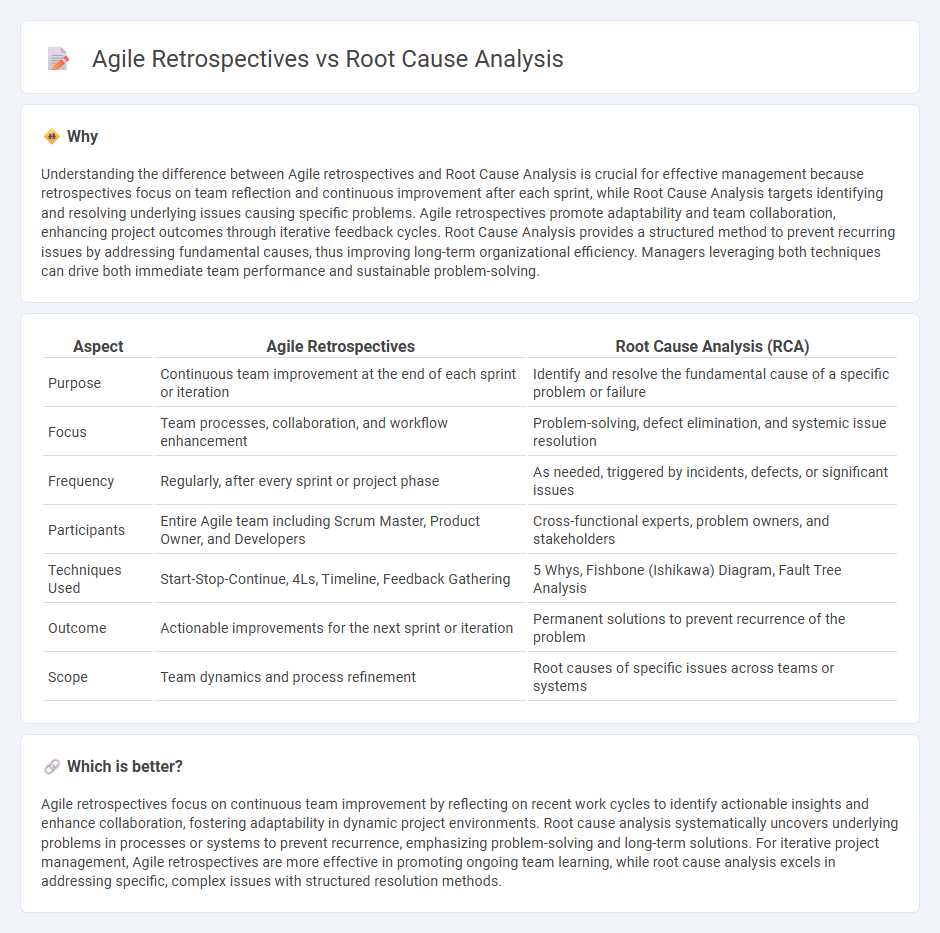
Agile retrospectives focus on iterative team reflection to improve processes and collaboration after each sprint, emphasizing continuous adaptation and collective learning. Root cause analysis systematically identifies underlying problems in workflows or systems by tracing issues back to their source, often using tools like fishbone diagrams or the 5 Whys technique. Explore how combining Agile retrospectives with root cause analysis can elevate project management effectiveness and team performance.
Why it is important
Understanding the difference between Agile retrospectives and Root Cause Analysis is crucial for effective management because retrospectives focus on team reflection and continuous improvement after each sprint, while Root Cause Analysis targets identifying and resolving underlying issues causing specific problems. Agile retrospectives promote adaptability and team collaboration, enhancing project outcomes through iterative feedback cycles. Root Cause Analysis provides a structured method to prevent recurring issues by addressing fundamental causes, thus improving long-term organizational efficiency. Managers leveraging both techniques can drive both immediate team performance and sustainable problem-solving.
Comparison Table
| Aspect | Agile Retrospectives | Root Cause Analysis (RCA) |
|---|---|---|
| Purpose | Continuous team improvement at the end of each sprint or iteration | Identify and resolve the fundamental cause of a specific problem or failure |
| Focus | Team processes, collaboration, and workflow enhancement | Problem-solving, defect elimination, and systemic issue resolution |
| Frequency | Regularly, after every sprint or project phase | As needed, triggered by incidents, defects, or significant issues |
| Participants | Entire Agile team including Scrum Master, Product Owner, and Developers | Cross-functional experts, problem owners, and stakeholders |
| Techniques Used | Start-Stop-Continue, 4Ls, Timeline, Feedback Gathering | 5 Whys, Fishbone (Ishikawa) Diagram, Fault Tree Analysis |
| Outcome | Actionable improvements for the next sprint or iteration | Permanent solutions to prevent recurrence of the problem |
| Scope | Team dynamics and process refinement | Root causes of specific issues across teams or systems |
Which is better?
Agile retrospectives focus on continuous team improvement by reflecting on recent work cycles to identify actionable insights and enhance collaboration, fostering adaptability in dynamic project environments. Root cause analysis systematically uncovers underlying problems in processes or systems to prevent recurrence, emphasizing problem-solving and long-term solutions. For iterative project management, Agile retrospectives are more effective in promoting ongoing team learning, while root cause analysis excels in addressing specific, complex issues with structured resolution methods.
Connection
Agile retrospectives and root cause analysis are interconnected tools in management that focus on continuous improvement by identifying underlying issues affecting team performance. Retrospectives facilitate team reflection on recent work cycles, while root cause analysis digs deeper into the fundamental problems revealed during these sessions. Combining both practices enhances problem-solving effectiveness and drives sustainable process optimization in Agile environments.
Key Terms
Problem Identification
Root cause analysis (RCA) systematically uncovers underlying problems using techniques like the 5 Whys and fishbone diagrams, providing deep insights into complex issues. Agile retrospectives facilitate team reflection to identify process inefficiencies and improve workflow through collaborative discussion and quick feedback loops. Explore how integrating RCA within Agile retrospectives can enhance problem identification and continuous improvement.
Continuous Improvement
Root cause analysis systematically identifies underlying issues to prevent recurrence, enhancing problem resolution efficiency across projects. Agile retrospectives foster team collaboration by reflecting on recent work cycles, promoting adaptive improvements within iterative processes. Explore how integrating root cause analysis with Agile retrospectives drives continuous improvement in dynamic environments.
Action Items
Root cause analysis systematically identifies underlying issues by examining defects or failures, emphasizing thorough problem-solving to prevent recurrence. Agile retrospectives foster team collaboration and continuous improvement by reflecting on recent iterations and generating actionable items for immediate implementation. Explore how integrating these approaches can enhance your team's problem-solving and productivity strategies.
 dowidth.com
dowidth.com